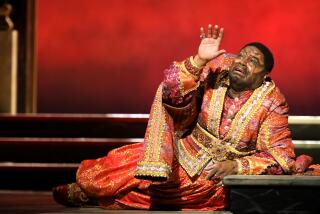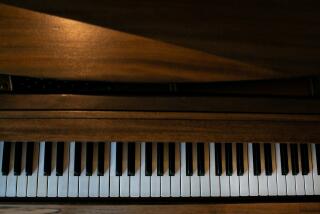He was transformed by Mozart
The morning commute was like any other — almost. As cars flew by on the northbound 710, I hit “play” on my iPod and a melody swept over me. Rush hour melted away.
“Ah-vey, ah-vey, veh-room corrrr-pooose,” the choir began. The Latin words open “Ave Verum Corpus” (Hail true body), a choral composition that has captivated listeners for more than two centuries.
I sang along, and I wasn’t doing it alone. At that moment, two friends in New Jersey and Georgia were singing the words as well. It was our new daily ritual, a pact we had made three months earlier.
PHOTOS: Rehearsing for ‘Ave Verum Corpus’
We were in upstate New York on a spiritual retreat when someone suggested forming a choir. We gathered on a warm August afternoon, 14 men and women around a piano. Soon we were holding three pages of sheet music and below the title was the composer’s name: W.A. Mozart.
The quarter, half and whole notes seemed manageable — I could read the music — but the musical notation offered no hint of how profoundly this compact piece was about to transform my life.
To this point, my singing career had consisted largely of belting out “Wooly Bully” and “(Hey Baby) Que Paso” in dive bars with my band, the Rounders.
After the two-measure introduction on the piano, the singers took their best shot at the Latin: Ave, ave verum corpus, natum de Maria virgine.
Those words, though, seemed secondary to the gracefulness of Mozart’s music. At the end of an hour practice, our voices blended on the right notes and words and the choir leader proposed performing it two nights later at dinner. It seemed a daunting challenge.
Leaving the hall, Dorothy Wasserman, a tap dancer and art teacher, and Debara Colmer, a visual artist, chatted about the unexpected Mozart workout. We had introduced ourselves a few days earlier when they’d started harmonizing on the gospel song “Down to the River to Pray” as we chopped vegetables for lunch.
Half the group huddled at 11 the next evening to keep working on the Mozart while the others headed off to their bunkhouses.
After dinner on the final night, we gathered at the piano and for the next four minutes tried to share with our friends the reverence we’d developed for the music.
As the last note dissipated, we stood motionless. Silence filled the room, a response more meaningful than any applause.
PHOTOS: Arts and culture in pictures by The Times
Ancient, but relevant
“Ave Verum Corpus” consists of 46 bars of music.
Writing just five months before he died, Mozart used the words from a 14th-century hymn about spiritual transformation, probably written by Pope Innocent VI. Translated, it reads:
Hail true body born of the virgin Mary
Having truly suffered, died on the cross for all mankind
Whose pierced side flowed with blood and water
May this be a foretaste of heaven during our final trial
The hymn was ancient, but the message seemed relevant: Life’s suffering might ultimately hold some meaning and serve a higher purpose.
As we packed up after our week in the mountains, Debara, Dorothy and I promised to stay in touch. We quickly hatched a plan for another group sing. Neither geography nor time zones would deter us.
On Aug. 16, at 4:30 p.m. for me and 7:30 p.m. for them, we would sing “Ave Verum Corpus” to a recording by the Westminster Cathedral Chorus. We wouldn’t hear one another; our commitment to the music would be our connection.
I checked my computer that evening for reactions. “What an incredible experience!” Dorothy e-mailed. Debara wrote: “Didn’t want to stop.”
None of us did. We came up with a pact to sing it three times a day at given times, and on weekends we’d talk over Skype about the experience.
I listened to at least two dozen versions, learning both the tenor and bass parts to more fully absorb Mozart’s piece.
PHOTOS: Rehearsing for ‘Ave Verum Corpus’
We found ourselves singing in unexpected settings. Dorothy ducked into her hairdresser’s bathroom. Debara sang it while visiting her 87-year-old mother in the hospital. I sang often while commuting in my Nissan, like that morning on the northbound 710, when the Ave Verum gave my usual frayed nerves a welcome sense of calm.
Mozart’s music became the accompaniment for our lives. Dorothy sang while helping plan her daughter’s wedding. Debara sang it as she awaited a grandchild’s birth. I sang it as I struggled with my son’s decision to quit high school.
The more we sang, the better we understood not only the music but also the silences — the rests Mozart built in to the piece that are as important as the melody or the harmonies.
Going public
After six months, our Mozart sessions trailed off. We had sung it more than 500 times.
I’d grown increasingly busy as a pop music writer at The Times when an advertising mailer arrived and caught my eye: The “Ave Verum” would be performed in Costa Mesa with Mozart’s Requiem.
I had a wild notion. I put in a call to officials at the Pacific Symphony and Pacific Chorale, recounted my Ave Verum experience, and asked: Might I join in? They agreed.
“I can’t even imagine singing it with pros,” Dorothy wrote. “Must be what Heaven on earth feels like….”
I was sitting with the tenors at the first rehearsal when a thick sheaf of music was dropped on my lap: the score for the Requiem, Mozart’s hour-long masterpiece.
Overwhelmed, I jumped in nonetheless with any notes I could manage. I needed no score when we turned to the “Ave Verum” and found my voice immersed with the choir. The music never sounded so sublime.
I had come for four minutes of music and now I’d be singing the entire program. It felt like I had conned my way into throwing the ceremonial first pitch at Dodger Stadium and then was invited to stick around and play the whole game.
Voice lessons
Exhilarated yet intimidated, I took my first voice lesson. Singing, the teacher stressed, is all in the breath, and I learned to control the flow of air to better support high notes and long phrases. The lessons resonated beyond Mozart.
At the next Rounders gig, the stratospheric notes in Neil Young’s “Powderfinger” were no longer out of range. And “Wooly Bully”? A snap.
Two nights before the first concert, the orchestra joined the choir, and from the first notes I felt the power of the Requiem washing over me.
Before starting the “Ave Verum,” music director Carl St.Clair paused, closing his eyes. “The reason I like doing the ‘Ave Verum’ after the Requiem,” he said later, “is that it allows listeners a moment to reflect on what they just experienced.” It would be the finale for the 2 1/2-hour program.
We filed into the choir loft on opening night and looked out at an audience of 1,800 in the Renee and Henry Segerstrom Concert Hall.
When the applause for the Requiem subsided, the orchestra played the first two measures of the “Ave Verum.” I could picture the small lake in the mountains where I had discovered the music 17 months earlier. I flashed back to the countless times I had sung this prayer for transformation in my living room, in my car, at my desk and, silently to myself, in meetings at work. I thought of my friendship with Dorothy and Debara. And of my son.
The words “Ave, ave” felt round, smooth, velvety rolling out of my mouth. The orchestra and 117 voices gave the music a bigger, broader and fuller sound, with a tactile richness absent from recordings. St.Clair reined it in to prevent crescendos from overwhelming the delicate mood.
After the violins’ closing notes, he kept his hands in the air. The audience, the orchestra, the choir and I remained frozen in time — and in silence.
A recording from the live broadcast of one of the Pacific Symphony and Pacific Chorale’s performance of Mozart’s Ave Verum Corpus discussed in this article can be streamed or downloaded here.
Twitter: @RandyLewis2
More to Read
The biggest entertainment stories
Get our big stories about Hollywood, film, television, music, arts, culture and more right in your inbox as soon as they publish.
You may occasionally receive promotional content from the Los Angeles Times.






